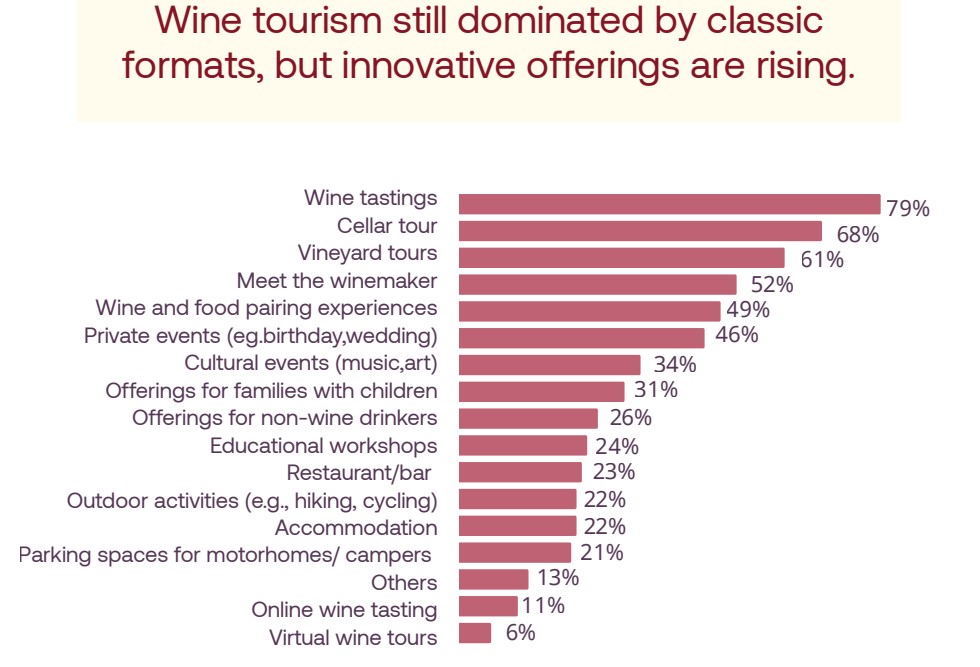Weintourismus erwirtschaftet 25 % der Einnahmen von Weingütern weltweit
Neuer globaler Bericht beleuchtet Rentabilität, Nachhaltigkeit und demografischen Wandel bei der Anpassung von Weingütern an sich verändernde Reisetrends
09.10.2025

Eine neue internationale Studie, die diese Woche veröffentlicht wurde, bietet den bisher detailliertesten Überblick über den Stand des Weintourismus in der Welt. Der Global Wine Tourism Report 2025, der von Professor Gergely Szolnoki von der Hochschule Geisenheim in Deutschland geleitet wird, stützt sich auf Daten von mehr als 1 300 Weingütern aus 47 Ländern. Der Bericht wurde auf der 9. UN-Weintourismuskonferenz in Bulgarien vorgestellt und wird auf den kommenden Branchenveranstaltungen in Bordeaux und Mainz präsentiert werden.
Die Untersuchung zeigt, dass der Weintourismus zu einem wichtigen Bestandteil der globalen Weinindustrie geworden ist, wobei zwei von drei Weingütern berichten, dass er profitabel oder sehr profitabel ist. Im Durchschnitt stammt heute etwa ein Viertel der Einnahmen eines Weinguts aus tourismusbezogenen Aktivitäten. Der Bericht hebt hervor, dass der Weintourismus nicht nur eine Einkommensquelle ist, sondern auch die Schaffung von Arbeitsplätzen und die Entwicklung des ländlichen Raums fördert und dazu beiträgt, lokale Gemeinschaften zu unterstützen und das kulturelle Erbe zu erhalten.
Nachhaltigkeit ist zu einem zentralen Element der Weintourismusstrategien geworden, wobei 66 % der Weingüter verantwortungsvolle Praktiken als wichtig oder sehr wichtig einstufen. Dieser Wandel spiegelt das wachsende Interesse der Verbraucher an umweltfreundlichen Reisen und die Notwendigkeit wider, angesichts wirtschaftlicher und ökologischer Herausforderungen langfristig stabil zu bleiben.
Der Bericht weist auch auf bedeutende Veränderungen in der Besucherdemografie hin. Während die Reisenden im Alter von 45 bis 65 Jahren nach wie vor die größte Gruppe darstellen, ist bei den Besuchern im Alter von 25 bis 44 Jahren ein schnelles Wachstum zu verzeichnen. Jüngere Touristen zeigen ein starkes Interesse an Weinerziehung, Nachhaltigkeit, Gastronomie und immersiven Erfahrungen. Dieser Trend zwingt die Weingüter zu Innovationen: Viele investieren in digitale Kommunikation, Storytelling und Partnerschaften mit lokalen Unternehmen, um neue Zielgruppen anzusprechen.
Trotz seines Wachstums steht der Weintourismus vor einigen Herausforderungen. Viele Weingüter, die sich noch nicht am Tourismus beteiligen, nennen Personalmangel und Zeitmangel als Haupthindernisse. Wirtschaftlicher Druck, rückläufiger Weinkonsum und regulatorische Fragen, wie z. B. Anforderungen der öffentlichen Gesundheit, schaffen ebenfalls ein fragiles Marktumfeld. Der Bericht stellt fest, dass die Zugänglichkeit und die sich ändernden Erwartungen der Besucher von den Weinkellereien mehr Anpassungsfähigkeit und Innovation verlangen.
Es gibt deutliche regionale Unterschiede. In Europa melden die meisten Weingüter stabile oder steigende Besucherzahlen, nur 17 % verzeichnen einen Rückgang. Im Gegensatz dazu melden 41 % der Weingüter in außereuropäischen Regionen einen Rückgang der Besucherzahlen, was die Notwendigkeit regionalspezifischer Strategien unterstreicht.
Kernaktivitäten wie Weinproben, Kellerbesichtigungen und Weinbergsbesichtigungen sind nach wie vor von zentraler Bedeutung für den Weintourismus. Diese Aktivitäten helfen den Besuchern, sowohl mit den Weinen als auch mit den Menschen, die hinter ihnen stehen, in Kontakt zu kommen. Gleichzeitig gibt es eine wachsende Nachfrage nach authentischen, lokalen und Nischenerlebnissen, einschließlich kulinarischer Angebote, umweltfreundlicher Praktiken und Aktivitäten in der Natur. Soziale Medien und digitale Kanäle spielen eine immer größere Rolle bei der Art und Weise, wie Weingüter mit Besuchern in Kontakt treten und ihr Angebot bewerben.

Die Aussichten für den Weintourismus sind optimistisch. Die Hälfte aller befragten Weinbaubetriebe plant weitere Investitionen in den Tourismus, und die meisten erwarten ein stetiges Wachstum für ihre Regionen und Unternehmen. Fast zwei Drittel sind der Meinung, dass der Weintourismus dazu beitragen kann, die Widerstandsfähigkeit in Krisenzeiten zu stärken, was ihn zu einer stabilisierenden Kraft für die Branche macht.
Der Globale Weintourismusbericht 2025 dient als Maßstab für Weingüter und politische Entscheidungsträger und bietet datengestützte Einblicke, wie sich der Weintourismus von einer Nischenaktivität zu einer zentralen Säule der ländlichen Entwicklung und des internationalen Marketings entwickelt hat. Die Ergebnisse werden im Laufe dieses Jahres auf Branchenkonferenzen in Frankreich und Deutschland weiter erörtert, und für Januar 2026 ist ein kostenloses Webinar geplant, um die Ergebnisse einem breiteren Publikum vorzustellen.
| Mehr Informationen |
|---|
| (PDF)Global WineTourism Report 2025 (Vollständiger Bericht) |
| (PDF)Globaler Weintourismus-Bericht 2025 (Kurzbericht) |
Vinetur® wurde 2007 gegründet und ist eine eingetragene Marke von VGSC S.L. mit einer langen Geschichte im Weinsektor.
VGSC, S.L. ist ein im Handelsregister von Santiago de Compostela, Spanien, eingetragenes Unternehmen.
E-Mail: [email protected] | Tel: +34 986 077 611
Hauptsitz und Büros in Vilagarcia de Arousa, Galicien